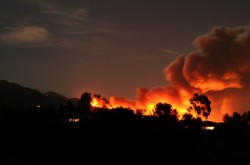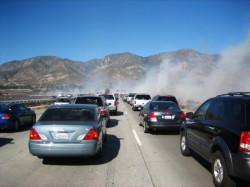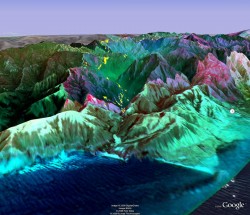[/caption]
This morning at 5:30am, I woke up to the smell of smoke. It’s one of those horrid, gut-wrenching feelings for anyone as your mind jumps from “did I leave the oven on?” to “oh no, it’s our turn.” The latter thought is probably one that everyone living near summer-dried woodland in California thinks on waking to the smell of smoke. And in the San Fernando Valley, we’ve had one or two scares this year.

This time, it wasn’t “our turn” as we live on the south-west side of the valley. But late last night, hundreds of families weren’t so lucky and had to be evacuated from their homes as fires raged along the northern edge of the LA County line up to Santa Barbara…
It was a strange atmosphere in the valley today. A huge smokestack was growing about 12 miles north, and brown smoke filled the air, filtering out much of the sunlight. Walking into the garden with my coffee after the disturbed night sleep, I noticed a thin layer of soot over the patio and table. It was eerily quiet. Add this to the unseasonably warm weather we are having, there was a real sense the raging wildfire was a lot closer than it was.

Last month was my last experience of a particularly vicious sequence of fires (again, causing huge problems for people in the north of the valley), and it looks like we have a few more days of trouble ahead of us. Governor Arnold Schwarzenegger has issued an emergency declaration for the Sayre fire in Sylmar and as I write, mandatory evacuations have been placed on some locations north of LA, down to Orange County. There is also the threat of rolling blackouts as the blazes deprive some areas of electricity supplies. The problem is spreading across the region.
Use Google Maps to monitor the areas affected in the region »
This afternoon, although life continued as normally as it could though the unhealthy haze of smoke trapped in the valley basin, I saw two yellow firefighting aircraft landing in Van Nuys airport, before flying north to assist the thousands of brave firefighters on the ground. We can only imagine how extreme it must be over there.

In July, when California was suffering a state-wide wildfire emergency (is it me, or has the wildfire season lasted a lot longer this year?), NASA flew a robotic Ikhana aircraft across much of the state, charting over 300 fires that had broken out. The Ikhana was using an Autonomous Modular Scanner developed at NASA’s Ames Research Center at Moffett Field to precisely measure temperature variations across the landscape from one-half degree to approximately 1,000 °F (537 °C). Areas currently burning and areas already burnt could then be identified. From this information, areas at risk could be quickly focused on, providing the firefighters with advanced warning before a fire takes hold.
“NASA’s emergency imaging gives us immediate information that we can use to manage fires, identify threats and deploy firefighting assets,” Governor Schwarzenegger said in July. “I thank NASA for providing us with this important firefighting tool.”
Whether or not the Ikhana aircraft is in the skies at the moment, it is unknown, but NASA has some other fire monitoring tricks a little higher in the sky.
From the MODIS Rapid Response System:
The Moderate Resolution Imaging Spectroradiometer (MODIS) flies onboard NASA’s Aqua and Terra satellites as part of the NASA-centered international Earth Observing System. Both satellites orbit the Earth from pole to pole, seeing most of the globe every day. Onboard Terra, MODIS sees the Earth during the morning, while Aqua MODIS orbits the Earth in the afternoon.
True-color, photo-like imagery and false-color imagery are available within a few hours of being collected, making the system a valuable resource for organizations like the U.S. Forest Service and the international fire monitoring community, who use the images to track fires; the United States Department of Agriculture Foreign Agricultural Service, who monitors crops and growing conditions; and the United States Environmental Protection Agency and the United States Air Force Weather Agency, who track dust and ash in the atmosphere. The science community also uses the system in projects like the Aerosol Robotic Network (AERONET), which studies particles like smoke, pollution, or dust in the atmosphere.
Here’s to hoping NASA’s resources are being made available as widely as possible as LA County is now in a state of emergency. Our thoughts are with the people who have been injured, displaced and lost their homes, and to the Fire Service who are fighting day and night to bring these blazes under control.
I hope we hear better news in the morning…
Sources: Examiner, CBS2, CNN, NASA Fire and Smoke, BBC


Im just happy im from denmark. Nothing ever happens here.
Interesting article, but can you clarify what you mean by “while Aqua MODIS orbits the Earth in the afternoon” – that must be an interesting orbit, what does it do in the morning?
Stuart: It’s always afternoon somewhere on the earth. It could always just orbit over the part that was experiencing afternoon at that time of day.
at that time of day.
I now realize how stupid this sounds. I should have justn ot said anything else there.
Good Luck
I can so totally relate to that. I’ve been right where you are now, not geographically, but situationally. Back in 2004 there was the worst wildfire season in memory in Portugal, and one of the greatest raged for days some 10 to 20 km north of where I live. Depending on where the wind was blowing, the air was as clean as if nothing wrong was happening, or suffocatingly clouded in smoke. It was an infernal week, with the fire constantly gaining new life, made worse for knowing people were loosing everything and even getting killed and I was absolutely powerless to do anything about it.
It rained ashes for days in my back yard. And even a vew charred eucalyptus leaves.
Still, and despite many of them being set up by arseners, people have to realize wildfires are a normal part of the mediterranean ecosystems, such as those in Southern Europe and California, so the best thing we can do to spare lives and property is to separate buildings from forest and undergrowth. Not as pretty, but a lot safer.
It raises the question into why would you keep rebuilding and not confronting the real problem! somewhat like New Orleans. Its like there more worried into getting the city back up and working then they are about the levy’s. Ignorant or just stupid either way there playing with peoples lives. I sincerely hope everyone gets to safety without incedent..
LLDIAZ, you get natural hazards everywhere. That’s a consequence of living in an active planet. When it’s not fire it’s floods, when it’s not hurricanes it’s drought, when it’s not earthquakes it’s blizzards, when it’s not avalanches it’s vulcanos. And on top of that you may get hit by an asteroid or even a stray unburnt piece of a satellite. If you don’t build where some natural hazard may destroy your home along with you, you can’t build anywhere on the planet.
So, what we have to do is to learn as much as we can about the hazards so that we can implement mitigating measures and predict their eclosion and development. In the case of wildfires, it’s simply a question of keeping a security distance from the woods, some 200 meters or so, and cover the buildings with non-combustible materials. And try to put it down, although that’s much easier said than done when the fire is really a big one.
I see what you mean but you miss my point, preperation is key ofcourse but how far will that take you when every other house around you is engulfed or flooded. My point is that if you fear a tsunami dont move to the coast, if you fear hurricanes stay away from Florida. Yes these disasters come on spontaneously but what then after?
Do we rebuild like San Fran after the quake and use worst materials then were before the quake. Thats what I mean my friend they act like its never going to happen again like this was the BIG one and there wont be more to come.
Ian, please, you and your wife stay safe! Like other readers of Universe Today, I truly hope the fires don’t come near your home, but if they do and the fire department says to evacuate, grab what you can and get out — your life and work is far more important than a house, however loved it may be! I was born in Southern California, and lived there — L.A. County, Ventura County, then Santa Barbara County — until I was 42, when I moved to Seattle, WA, where I am now. We had brushfires there all the time, but somehow they are getting worse every year, probably as a result of global warming and the severe droughts hitting the US West Coast over the past few years. I miss So Cal terribly, but not the fires, which have done so much harm this last decade or so. Stay safe. Maybe make a concrete basement bunker for the things you can’t afford to lose, or put them in a safety-deposit box in a bank — unfortunately, the fires will happen again and again, just about every year, and the odds aren’t zero that you may lose a house to one as long as you live in that area. Best wishes to you and your wife, and thank you for your wonderful articles on Universe Today.
build in denmark. nothing ever happens here. we have never had any problems what so ever
Yes, I totally agree, let’s move *EVERYONE* from California to Denmark!
Of course, this could have to do with me not wanting them in Colorado or Montana or Washington.
# kenn Says:
November 16th, 2008 at 4:24 am
“Im just happy im from denmark. Nothing ever happens here.”
Sounds thrilling.
Being from Sydney, Australia, we’re well versed in the danger of bushfires – like in California, there are serious fires along the south-east of Australia every year with truly devastating fires occurring every five or so years. People may remember when the Mt. Stromlo observatory burnt to the ground in Aus. near Canberra not too many years back. I have some mates that are fireys, and almost without fail each year they head off to bushfires around the state to do battle for weeks at a time with little or no rest. Any assistance from NASA or the like would be well received I’m sure.
Here’s hoping the people of California can get through this relatively unscathed…
Some years ago Tomorrows World reported about an Australian who lived in a similar area but who was prepared. He had built a pond filled with sufficient water added an old tractor that would start at a moments notice with a pump attached that was attached to the house and the house was fitted with a spray system that simply sprayed a fine spray of water, (not a very large amount, but just sufficient to keep the surface wet for a short period, no more than an hour), over the roof and roof edges so that if a fire did occur, he could prevent the house burning. His was the only house in the area to survive and his house was totally undamaged. where all his neighbours were burnt to the ground.
It seems to me that if you are in such a fire risk area, the relatively minor expense and inconvenience would be the best investment you could ever make.
Food for thought.
Are there any oil rigs near that fire or in the area?
I guess that the correct interpretation of NASA’s data is a science by itself. There are so many disaster locations on the planet, and NASA cannot be transformed into a crisis management group.
So I guess that the experts that are capable to interpret and use NASA’s data need to be experts who are employed at the local action forces itself.
The speciality of NASA lies in the operating of probes that collect information. The interpretation of the significance of those data for an actual disaster should be in the realm of local teams of experts which support the operation controllers with realtime informaiton. There should be highly skilled experts on a certain level of local hierarchies. And NASA should be willing and able to provide data anytime and anywhere.
Protocols and interfaces should be established between the providers of space-based entities and the forces on site. Thus an executive staff – whether fighting water or fire or whatever disaster – could always hook in on demand.
It should be possible just to contact NASA and say: “Hey, please do focus on that special local event with appropriate sensors right now. Just provide us with the info. We will tell you when we have done. Appreciate!”
We’ve had bushfires for ever here in Victoria, Australia. In the 1939 fires, a large chunk of the state was burnt out, I’m guessing maybe about the size of the US state of Vermont, or most of the country of Denmark, or more.
Part of the problem is our Gum (Eucalyptus) trees, which contain a high fraction of oil, so in dry conditions they burn easily and fiercely. We also have droughts (we’ve been in one for 8 years now), and hot dry winds, in our case from the north coming from the interior of the country. Similar to California really.
We think we’re safe here in the middle of suburban Melbourne, but several years ago we had a grass fire in the parkland behind our property. The grass was only a few inches high, but the flames from that were still over my head, and, with the wind behind it, it travelled at a reasonable running pace. We were lucky!
My wife and I have several friends who’ve lost their homes to bushfires over the years, so my heart goes out to those near LA.
a reminder of the fragility of life everywhere. glad you’re ok!
we forget all the time how dangerous and volatile the world can be. i mean, if yellowstone national (which is an active volcanic area) ever went full bore it could bury everything west of the mississippi river. goodbye western united states.
everything and anything is possible. it’s good to be thankful when life is seeemingly mundane.